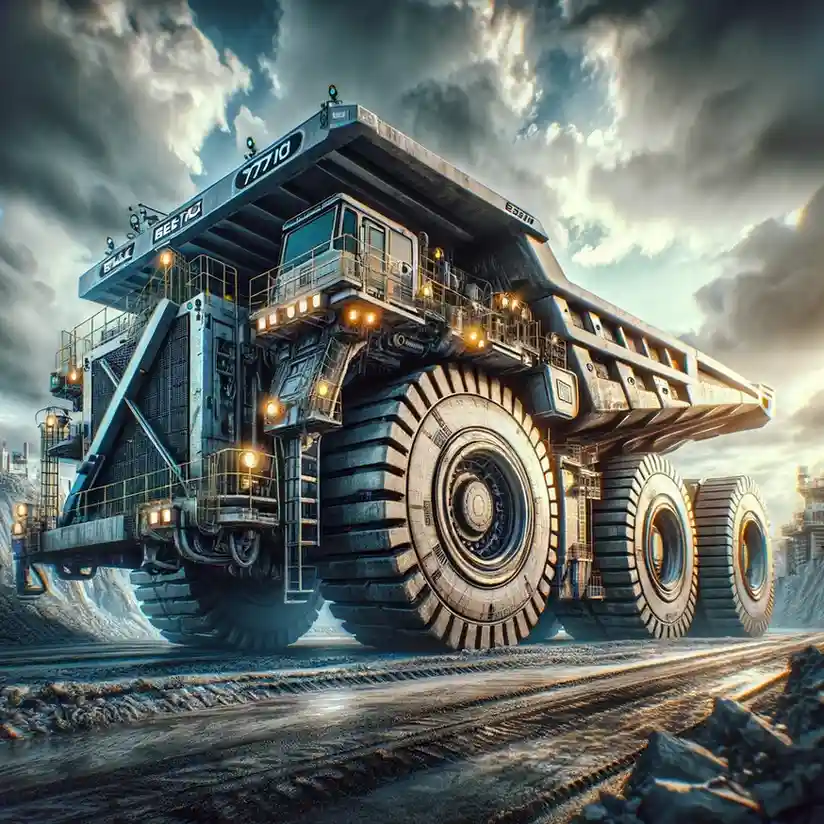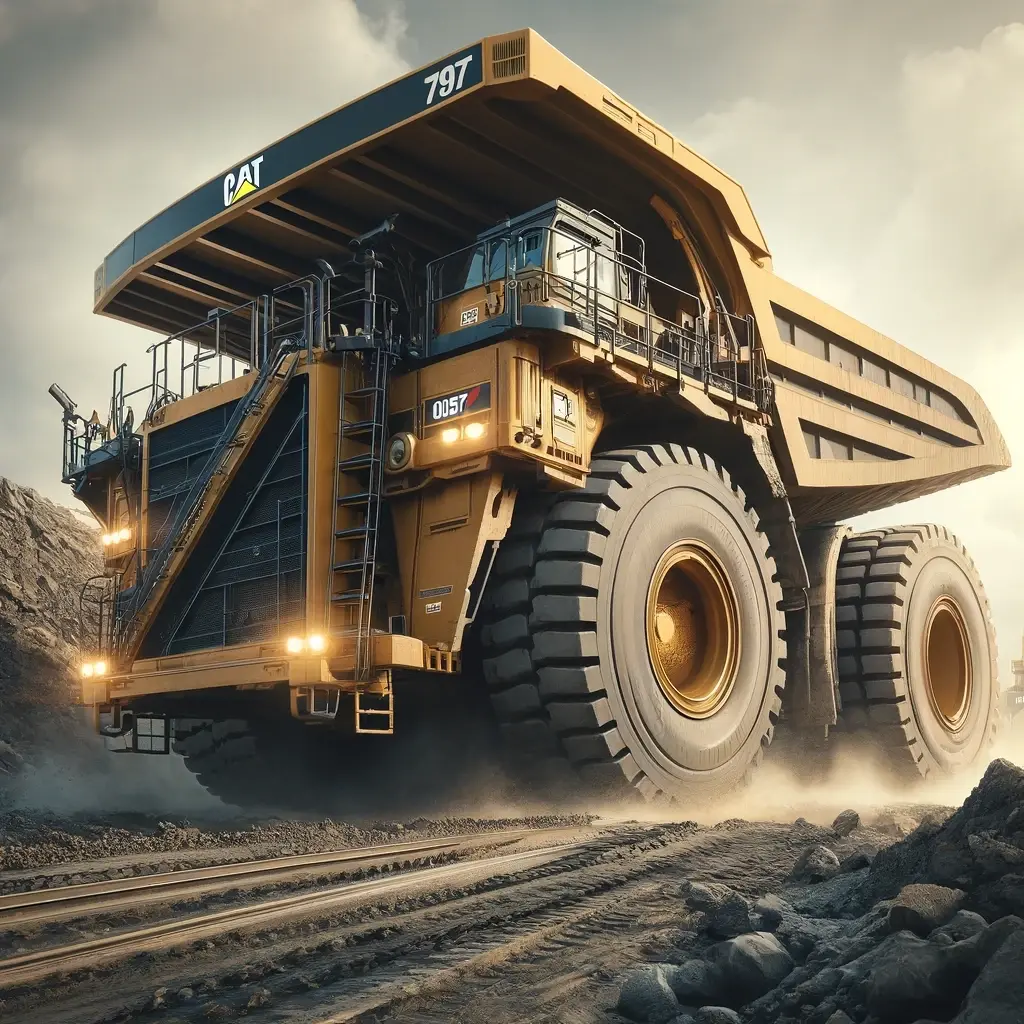Introduction:
Picture a scenario where trucks are enormous, making vehicles seem tiny in comparison and able to transport a whole house in a single trip! Step into the world of the trucks, on the planet, the titans of the mining sector. These massive machines aren’t just known for their size but for their strength, effectiveness, and cutting-edge technology. In this article, we’ll delve into the ten trucks of 2024, shedding light on their characteristics, capabilities, and significance in various industries worldwide.
The Titans of the Mining Industry;
Haul trucks, also known as mining trucks, play a role in mining activities across the globe. Their efficiency in transporting quantities of materials serves as the cornerstone of the mining sector. Let’s explore in detail these machines, their advanced technologies, and their significant impact on large-scale mining and construction projects.
Table of Contents
BelAZ 75710: The Ultimate Behemoth
Payload Capability;
Able to transport 450 tons.
Propulsion System;
Driven by dual diesel engines generating a total of close to 5,000 horsepower.
Distinctive Characteristics;
Its substantial dimensions and performance are enhanced by its dual fuel capability, which allows it to operate on both diesel and liquefied natural gas, minimizing its footprint.

Here’s a comparison table for some of the largest trucks in the world, which showcases key specifications such as payload capacity, engine power, and notable features. This table can be a helpful visual aid in understanding the differences and unique attributes of each truck model:
| Truck Model | Manufacturer | Payload Capacity (metric tons) | Engine Power (horsepower) | Notable Features |
|---|---|---|---|---|
| BelAZ 75710 | BelAZ | 450 | 4,600 | Dual fuel (diesel and LNG), enormous size |
| Caterpillar 797F | Caterpillar | 400 | 4,000 | High durability, excellent for long-distance hauling |
| Komatsu 980E-4 | Komatsu | 400 | 3,500 | Electric drive, LED lighting, advanced air filtration |
| Liebherr T 284 | Liebherr | 363 | 4,000 | Diesel-electric power system, focus on fuel efficiency |
| Terex MT 6300AC | Terex | 360 | 3,750 | Combines power with fuel efficiency |
| Hitachi EH5000AC-3 | Hitachi | 326 | 2,700 | AC-drive technology, semi-automated features |
| Caterpillar 795F AC | Caterpillar | 313 | 3,400 | Robust electric drive system, tailored for high performance |
| BelAZ 75601 | BelAZ | 320 | 3,800 | Known for its reliability and performance in extreme conditions |
| Komatsu 960E-2K | Komatsu | 327 | 3,500 | Efficient diesel-electric powertrain, optimized load capacity |
| Liebherr T 282C | Liebherr | 400 | 3,650 | High efficiency mechanical drive, fast and agile |
This table highlights the diversity in design, capacity, and technological advancements across different models and manufacturers. Each truck has been developed with specific operational conditions in mind, reflecting the targeted needs of their respective industries. By comparing these trucks side-by-side, readers can better appreciate the technological and engineering marvels that these vehicles represent.

Caterpillar 797F: The Durable Powerhouse
Payload Capacity;
It can carry up to 400 tons.
Engine and Power;
It comes with a 20-cylinder engine that generates around 4,000 horsepower.
Safety Features;
The truck has state-of-the-art tire monitoring and temperature detection systems to ensure safety.
Komatsu 980E-4: The Electric Giant
- Payload Capacity: 400 metric tons.
- Engine and Power: Features an electric-drive system that offers significant fuel savings and reduced emissions.
- Innovative Technologies: LED lighting for enhanced visibility and safety and an advanced air filtration system.
Liebherr T 284: The Lightweight Innovator
- Payload Capacity: 363 metric tons.
- Engine and Power: Combines a diesel-electric power system with exceptional power efficiency.
- Environmental Impact: Focuses on fuel efficiency and reduced carbon emissions without compromising performance.
Terex MT 6300AC: The All-Rounder
- Payload Capacity: 360 metric tons.
- Engine and Power: Sports a 20-cylinder engine that balances power and fuel efficiency.
- Gross Operating Weight: Weighs over 660,000 pounds when fully loaded.
Hitachi EH5000AC-3: The Technological Marvel
- Payload Capacity: 326 metric tons.
- Engine and Power: Features advanced AC-drive technology.
- Automated Driving: Includes semi-automated driving features for operational safety and efficiency.
Caterpillar 795F AC: The Robust Performer
- Payload Capacity: 313 metric tons.
- Engine and Power: Utilizes an electric drive system tailored for high performance and longevity.
- Leading Manufacturers: Demonstrates Caterpillar’s commitment to leading-edge technology and durability.
BelAZ 75601: The Reliable Workhorse
- Payload Capacity: 320 metric tons.
- Engine and Power: Known for its robust build and reliable performance in extreme conditions.
- Tire Size and Maintenance: Features some of the most giant tires in the industry, designed for maximum durability.
Komatsu 960E-2K: The Efficient Juggernaut
- Payload Capacity: 327 metric tons.
- Engine and Power: Highlights efficiency with its diesel-electric powertrain.
- Load Capacity: Optimized for maximum load capacity and minimal environmental impact.
Liebherr T 282C: The Speedy Transporter
- Payload Capacity: 400 metric tons.
- Engine and Power: Stands out with its exceptional speed and agility for a truck of its size.
- Mechanical Drive: A high-efficiency mechanical drive system enhances operational speed.
Conclusion:
The giants in the mining sector need to showcase top-tier engineering and creativity. It also symbolizes the continuous progress in heavy machinery and environmental care. These trucks advance yearly, emphasizing sustainability, safety, and effectiveness. Whether it’s the load-carrying ability of the BelAZ 75710 or the groundbreaking electric propulsion systems of Komatsu trucks, these vehicles persist in expanding the horizons of what can be achieved in the mining and construction sectors.
FAQ: Understanding the Largest Trucks in the World
Q1: What defines a truck as one of the largest in the world?
A1: Trucks are classified as some of the largest based on their payload capacity, which is the maximum weight they can carry. Additional factors include their gross operating weight, dimensions, and the horsepower of their engines.
Q2: Why are these large trucks primarily used in mining?
A2: These trucks’ massive payload capacities and robust build make them ideal for mining operations, where large amounts of earth and ore must be moved efficiently over rugged terrain.
Q3: What are the benefits of using electric drive systems in these trucks?
A3: Electric drive systems offer improved fuel efficiency, reduced emissions, and lower maintenance costs than traditional mechanical drive systems. They also provide better torque management and smoother operation.
Q4: How do safety features vary among the most significant trucks?
A4: These large trucks have safety features such as advanced braking systems, collision avoidance systems, tire pressure monitoring, and sophisticated onboard diagnostics to ensure operator safety and efficiency.
Q5: What role does tire size play in the functionality of large haul trucks?
A5: Larger tires are crucial for distributing the weight of the loaded truck, improving stability, and enhancing mobility on soft or uneven ground, which is common in mining environments.
Q6: How do manufacturers like Caterpillar, Komatsu, and Liebherr contribute to the evolution of these trucks?
A6: These manufacturers invest in research and development to introduce fuel efficiency, automation, and environmental sustainability innovations. They continually improve design and technology to meet the changing needs of industries.
Q7: What is the environmental impact of these large trucks, and how is it managed?
A7: Due to their size and operations, these trucks traditionally have a significant environmental impact. Manufacturers mitigate this by developing fuel-efficient engines, using alternative fuels, and incorporating electric drive systems to reduce carbon emissions.
Q8: Can these trucks be used in other industries apart from mining?
A8: While primarily designed for mining, these trucks can also be used in large-scale earthmoving projects, dam construction, and other applications requiring the movement of large volumes of material.
Q9: What are the challenges in maintaining such large trucks?
A9: Maintenance challenges include the high cost of parts and service, the need for specialized maintenance facilities and tools, and the training required for technicians to handle complex, high-tech systems.
Q10: Where can one see these trucks in action?
A10: These trucks are primarily operated in large open-pit mines and are not generally accessible to the public. However, many mining companies offer mine tours where you can see these trucks in operation, and numerous documentaries and online videos are available.
These FAQs provide:
- A broad understanding of the giant trucks used in industries worldwide.
- Highlighting their capabilities.
- Technological advancements.
- The challenges they address in modern engineering and mining operations.












